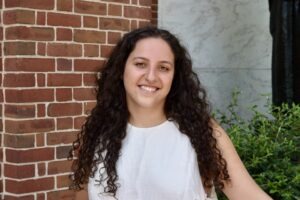Ever since Hadas Elazar-Mittelman was a child, she had an interest in chemistry and materials science. She was often found manipulating Silly Putty, the malleable rubber toy, into odd shapes, as well as bending and breaking objects to see how or if their shapes changed. By the fifth grade, she begged her science teacher, Sharon Turpie, to light objects on fire so she could watch the reaction and see how it transformed the material. Her family and teachers, particularly Turpie and Daniella Munteanu, her high school chemistry teacher, nurtured that interest, and she learned a lot about materials science and engineering before she even had a vocabulary to know it existed as a profession.
During her second-year of undergraduate studies at the University of Maryland, Elazar-Mittelman was introduced to materials science and engineering as a discipline. She found herself drawn to materials engineering for sustainable applications during her senior capstone project, which introduced her to the world of carbon capture, utilization, and storage. She even interned at the Johns Hopkins Applied Physics Laboratory where she was exposed to interesting and challenging materials and chemistry problems in environmental resilience and chemical sensing.
Eventually, the APL offered Elazar-Mittelman a full-time position as a materials engineer where she enjoyed working on diverse research projects, leading a team of interns, and proposing new research areas. While she enjoyed the work, she knew she needed more training, and her APL mentors encouraged her to pursue a PhD. Now a fourth year PhD student, Elazar-Mittelman is studying carbon negative technologies under the mentorship of Michael Tsapatsis, core researcher at the Institute for NanoBioTechnology and Bloomberg Distinguished Professor in the Department of Chemical and Biomolecular Engineering, and Jonah Erlebacher, professor in the Department of Materials Science and Engineering.

Hadas Elazar-Mittelman
What are you researching?
I’m interested in carbon negative technologies, particularly carbon footprint reduction in construction and infrastructure sectors. My research focuses on chemical and material pathways to permanently sequester carbon dioxide—that is—transform it to a solid. There is a lot of research that focuses on transforming carbon dioxide to fuels, but ultimately these fuels re-emit carbon dioxide. As a solid, there is no re-emission as the final product is intended to remain a solid. I’m exploring the chemical reduction of carbon dioxide using magnesium metal, called magnesiothermic reduction. I initially studied how to use magnesiothermic reduction to manufacture structural carbon composites from carbon dioxide, but now I am studying how the same chemistry can transform cement manufacturing into a potentially net-negative emissions process.
What are the challenges to studying carbon negative technologies?
Technologies that capture and repurpose carbon, also known as carbon utilization technologies, are challenging from a technological and economic perspective. Carbon dioxide is a very stable molecule. It requires a significant amount of energy to convert it to other chemicals and materials, especially solid carbon. Given this significant energy requirement, we must assess the technoeconomics and efficiency of potential solutions. Additionally, we must consider emissions generated during the production and transport of goods because these embodied emissions, as they are called, contribute significantly to overall technology emissions. Some technologies could result in emitting more carbon dioxide than they consume. If these technologies are to support our global emission goals, they also need to address scalability issues and produce a product that fulfills a market need. Additionally, emissions associated with materials used in the construction and infrastructure sector, such as cement and concrete, include significant embodied emissions, which are difficult to mitigate because of how these materials are traditional sourced and manufactured.
What are you doing to try to overcome these challenges?
Our lab team has found that interesting research questions arise when we consider not just the core technology but from where and how the different chemical components of the technology are sourced, and how they are manufactured. We consider a lot of factors such as the sourcing and sustainable manufacture of raw materials, alternative heat sources that consume rather than emit carbon dioxide, the technoeconomic and life cycle assessment of a given technology, and process and product improvements. Right now, I am focused on studying how we can use the magnesiothermic reduction reaction to provide heat to the cement manufacturing process, and produce solid carbon and magnesium oxide powders for use in cement and concrete. Employing a “waste-to-use” strategy by using carbon dioxide as a part of our heat source can help lower the embodied emissions of a process, and overall, potentially make the economics more favorable.
What are the impacts of your research if successful?
The building and construction sector accounts for over 35% of our total carbon emissions. Embodied emission accounts for a significant fraction and are difficult to mediate. If successful, we can create carbon negative building materials from by-products sourced from common waste streams, such as mine tailings, that also contain solid carbon derived from carbon dioxide. This would significantly reduce cement manufacturing emissions while demonstrating a viable path for using our build environment as a means of solid carbon storage. My hope is that the work we are doing in translating the magnesiothermic reduction chemistry to larger scale manufacturing applications will inspire creativity in developing negative-emissions technologies for materials production.
Are you involved in any Hopkins student groups?
I am a student representative for the Graduate Student Association at the Ralph O’Conner Sustainable Energy Institute. I previously served as co-president and director of department engagement in the Materials Graduate Society. I also founded the Hopkins Catalysis Club, a community interest group that brings students, post-docs, and professors in materials science and engineering, chemical and biomolecular engineering, and chemistry together to share research and participate in a journal club about topics related to catalysis, surface science, and materials.
When you are not doing research, what do you do in your spare time?
I really love teaching and working with students. I was a tutor for over 10 years and still tutor a few students in my free time. I typically tutor students in grades 7 through 12 in math and science, but I’ve also tutored clients pursuing bachelor’s and master’s degrees. I’ve even tutored some people who went back to school in their 70s!
I also mentor students in the Quality Enhancement Systems and Teams (QUEST) program, where I am an alum, at the University of Maryland. It is an honors program for undergraduates studying business, engineering, and the sciences that focuses on completing experimental learning projects. I visit the capstone course to support the initial project phases in determining a statement of work and helping the team form a vision for their client engagement.
Outside of tutoring and mentoring, I enjoy cooking and regularly experiment in the kitchen with new recipes and cuisines. Additionally, I like painting and took an oil painting class at Hopkins that was an incredibly rewarding experience. You can also find me playing tennis and being active outdoors in general.
This story was written by Gina Wadas and originally appeared on the Institute for Nanobiotechnology website.
